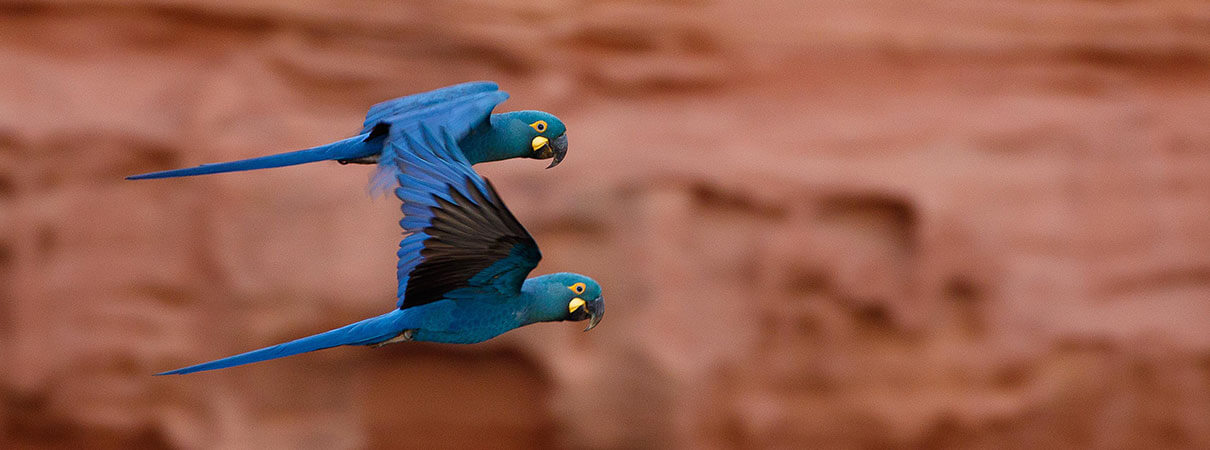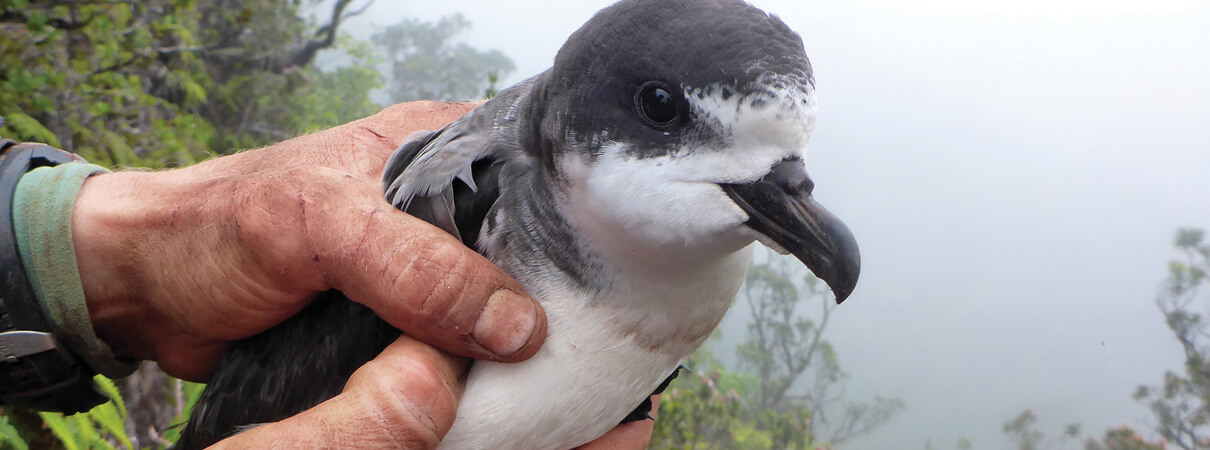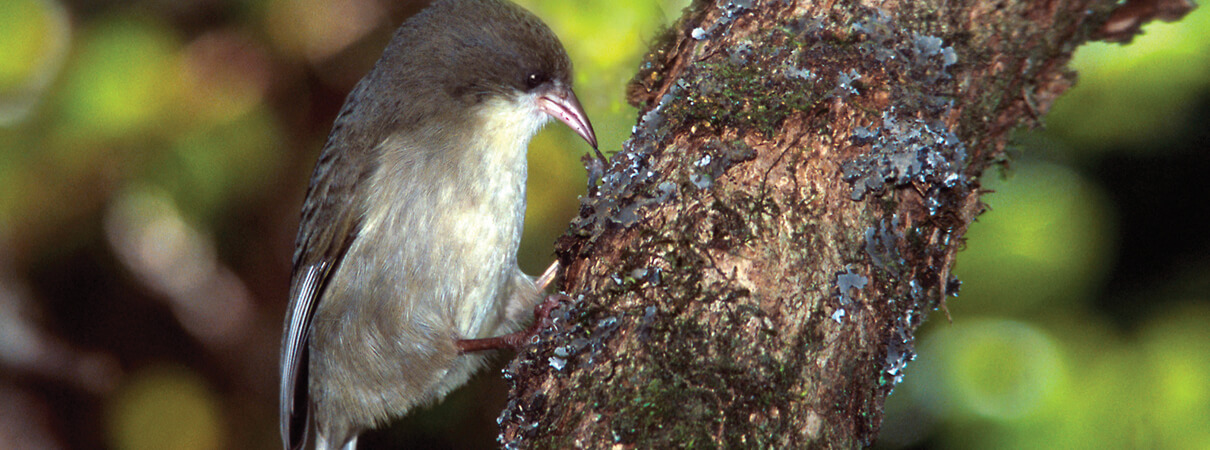At the pinnacle of ABC's Bird Conservation Framework, we work to prevent extinction of the Western Hemisphere's most endangered birds, creating and sustaining protected areas to provide essential habitat and reducing threats to birds within those habitats.
Priority bird species at this level include those listed on the IUCN Red List of Threatened Species, such as Stresemann's Bristlefront in Brazil and Blue-billed Curassow in Colombia, as well as species found in the United States and listed under the U.S. Endangered Species Act, including mainland species, such as the Piping Plover and California Condor, and Hawaiian birds such as the 'Akikiki and 'Akeke'e.
There have been 15 bird extinctions in the Americas over the past 50 years (most in Hawai'i). Today, the majority of endangered birds outside the U.S. have at least some populations in protected areas, but significant gaps remain, and only 18 percent of the most threatened species can be considered effectively protected from extinction at present.
In the U.S., more endangered birds are increasing than are declining, but Hawaiian species in particular need much more recovery support.
Overall Status of Birds
(Much of the data generated in this section was derived from BirdLife International's DataZone. Please visit their site for more specifics.)
Fifteen bird species have gone extinct in the Americas and U.S. Pacific Territories since 1968, most in Hawai'i. These species are the Aguijan Reed-warbler, Alagoas Foliage-gleaner, Atitlan Grebe, Bishop's Oo, Bridled White-eye, Colombian Grebe, Cryptic Treehunter, Guam Flycatcher, Guam Reed-warbler, Kamao, Kauai Akialoa, Kauai Oo, Least Vermilion Flycatcher, Pagan Reed-warbler, and Po'ouli.
Five more bird species have been declared extinct in the wild but survive in captivity: the Alagoas Curassow, Guam Kingfisher, ʻAlalā (Hawaiian Crow), Socorro Dove, and Spix's Macaw. (Reintroduction efforts are underway for some of these species.)
Scientists believe that an additional 17 bird extinctions have been averted by conservation intervention since 1994 (the year ABC was founded).
Conservation Outcomes
ABC prioritizes its work to halt extinctions by identifying the species at greatest risk, based on the IUCN Red List and the U.S. Endangered Species Act list, and then works with partners to identify conservation opportunities and to develop field-based conservation projects, species by species. We especially prioritize sites where Endangered or Critically Endangered species are confined to a single site (Alliance for Zero Extinction or AZE sites).
Of the 17 bird species extinctions considered to have been averted since 1994 in the Americas, ABC has provided significant support to efforts to prevent five:
1. Alagoas Antwren
2. Junin Grebe
3. Lear's Macaw
ABC also played a contributory role in the case of a further species, the California Condor.

The Lear's Macaw, one of the species ABC and partners have helped bring back from the brink of extinction. Photo by Maggie Forrester
Action Highlights
ABC supported ECOAN's community outreach and pollution control programs to help conserve the Junin Grebe in Peru.
ABC and AZA supported the development of a vaccine to inoculate captive California Condors against West Nile Virus, and ABC pressed successfully for a ban on lead ammunition in condor range counties in California, since condors scavenge on hunted deer carcasses.
With Biodiversitas, ABC helped expand the Canudos Biological Station in Brazil to 3,649 acres, helping the Lear's Macaw population grow to 1,300, and downgrading the Macaw from Critical to Endangered.
ABC helped to oppose a hotel development, advocated for habitat conservation, and is helping the Grenada Dove Conservation Program control invasive mongooses by providing support for traps to protect the Grenada Dove.
ABC supported a CECIA expedition that rediscovered the Pale-headed Brushfinch, and helped Fundacíon Jocotoco to acquire the 400-acre Yunguilla Reserve in Ecuador, which has helped the brushfinch increase to more than 200 birds, downgrading the species from Critical to Endangered.
Overall Status of Birds
According to BirdLife International scientists, there are currently 263 IUCN-Red Listed Endangered (EN) and Critically Endangered (CR) bird species in the Americas and U.S. Pacific Territories.
For 189 of these, habitat loss is considered the principal threat. Thirty-six have 500 or more individuals in one or more protected area/s, affording those species significant protection against imminent extinction; 179 have some protected populations, but 10 have no protected populations at all.
The remaining 74 species are primarily threatened by other factors, such as invasive species, for which equivalent extent of protection metrics are not yet available.

The Royal Sunangel, found only in Peru and Ecuador, is an ABC focal species primarily threatened by habitat loss. Photo by Carlos Calle
Conservation Outcomes
Of the 189 EN and CR species primarily threatened by habitat loss, ABC-supported projects (such as bird reserves) currently provide some protected habitat for 82 species (43%). Extinction risk is believed to have been significantly reduced for 14 of these species so far.
ABC has contributed significantly to the conservation of 11 species that are estimated to have at least 500 individuals within protected areas:
1. Baudo Guan
2. Black-cheeked Ant-Tanager
3. Black-fronted Piping-Guan
4. Boa Nova Tapaculo
9. Santa Marta Sabrewing
10. Speckle-chested Piculet
A further three ABC focal species have 100% of their range protected, but still number fewer than 500 individuals:
ABC currently works on 23 of the species threatened primarily by invasive species or other factors ― mostly seabirds and Hawaiian birds.
Action Highlights
With partners, as of the end of 2021, ABC had supported the acquisition/protection of 1,192,401 acres of land at 103 sites in 15 countries, with 51 partners. We have also supported the planting of 6,813,945 trees and shrubs in reserves and buffer areas.
In total, 2,900 bird species have been recorded in ABC-supported reserves (66% of all bird species found in the Americas).
ABC has supported new and expanded reserves for some of the Americas' most endangered birds, including the Antioquia Brushfinch, Banded Ground-Cuckoo, Blue-throated Hillstar, Lilacine Amazon, Red-fronted Macaw, and Short-crested Coquette.
ABC worked with the Convention on Biological Diversity and the governments of Brazil and Mexico to make government protection of additional EN and CR species confined to single sites (AZE sites) a global policy priority.
With GECI, ABC has supported the removal of cats from Socorro Island, Mexico, to help save the Townsend's Shearwater from extinction.
In 2018, our partner ECOAN and ABC supported the protection of more than 45,000 acres of cloud forest in northern Peru, sheltering Long-whiskered Owlet and other rare birds.
ABC has supported work that has led to the discovery or rediscovery of nine bird species including the Antioquia Brushfinch, Tachira Antpitta and Yellow-eared Parrot. ABC has supported nest box programs for seven threatened species including the Blue-throated Macaw and Gray-breasted Parakeet (the latter helping fledge 841 chicks of this EN species).
ABC staff participated in an expedition to search for additional populations of the Critically Endangered Antioquia Brushfinch in Colombia. Remarkably, the team found birds at eight localities, five of them newly discovered sites for the species. Altogether, the 20 to 25 birds seen represent at least a two-fold increase in the known global population of the species, offering new opportunities for its conservation.
A record 12 Blue-throated Macaw chicks fledged from nest boxes at the 1,690 acre Laney Rickman Reserve in Bolivia during the 2018-2019 nesting season, bringing the all-time total of fledglings produced from Asociación Armonía's artificial nest boxes to 81 — a significant contribution to a global population that may not exceed 450 in total. ABC helped Armonía create the new Blue-throated Macaw reserve and continues to support the nest box program.
After supporting a new conservation model for the Endangered Kaempfer's Woodpecker, ABC provided emergency support to Brazilian partner Instituto Araguaia to contain and extinguish a fire that was threatening key habitat for the species. Dozens of fire-fighters were hired at short notice to help tackle the blaze, which fortunately did not cause extensive damage.
A female Stresemann's Bristlefront was filmed and photographed on October 2, 2019 just outside of the Mata do Passarinho Reserve, which is supported by ABC through its partner group Biodiversitas. This confirms the continued survival of the species, albeit with only a single known bird at present. This gives us hope, however, that if searches for additional birds are successful, the species can still be saved.
The first Endangered Peruvian Diving-Petrels have returned to Isla Chañaral where ABC, Island Conservation, and the Chilean national park agency (CONAF) are collaborating on a project to install artificial burrows, cameras, and speakers to attract petrels to nest. Almost immediately petrel footprints were found at the artificial burrow entrances.
The first protected area for the Critically Endangered Marsh Antwren was established in São Paulo state, Brazil, with ABC support. The new reserve spans 5,860 acres and was declared by the municipality of Guararema working with the local organization Guaranature and SAVE Brasil.
In a bid to prevent the extinction of the Lilacine Amazon – a colorful parrot found only in western Ecuador – ABC supported the establishment of the Las Balsas Communal Reserve by our partner, Fundación Jocotoco, to protect a vital roosting site for the Endangered species.
An ABC project to locate previously unknown nesting areas of the white-faced form of the Black-capped Petrel succeeded when on September 30 a satellite tracked bird crossed into the Dominican Republic, revealing a potentially new nesting area east of known colonies, and at an earlier date than birds usually return to nest. In other seabird news, ABC has begun the process of bidding out a fence construction project for northwestern Molokai in Hawaii, where we hope to attract Laysan Albatrosses to nest on high cliffs safe from rising seas.
After years maturing at sea, the first 'A'o (Newell's Shearwaters) and ʻUaʻu (Hawaiian Petrels) returned to the Nihokū fenced area on Kauai, carefully prepared by a consortium of partners including ABC. The birds were translocated to the site as chicks; their return represents encouraging progress in our work to create a thriving, predator-free breeding area for rare seabirds.
Overall Status of Birds
The U.S. Endangered Species Act (ESA) has different species selection criteria to the IUCN Red List, and it also includes subspecies and populations. ABC uses both lists to help set priorities and to track conservation progress.
In 2016, an ABC report documented that 38 ESA-listed species were increasing, 15 were stable, 24 declining, and 17 were of uncertain status or extinct (most of these being Hawaiian species already close to extinction in 1973 when the Act was passed). The report also revealed that 29 species showed status improvements over the most recent prior U.S. Fish and Wildlife Service assessment (conducted in 2010), and that only five had deteriorated.
Note that there is considerable overlap between the IUCN Red List, the U.S. Endangered Species Act list, and the U.S. WatchList, so the number of species ABC provides as ones it works on in these categories is not cumulative.

Piping Plover, an ESA-listed bird that has benefited from ABC's efforts to protect breeding habitat in New York. Photo @ Michael Stubblefield
Conservation Outcomes
Of the 20 ESA-listed bird species that ABC has worked on most directly, seven were considered to be increasing in the 2016 ABC report:
(Kirtland's Warbler was removed from the ESA in 2019.)
See ABC's 2016 Endangered Species report.
Action Highlights
With the U.S. Fish and Wildlife Service (FWS), ABC helped translocate 50 Millerbirds from Nihoa to Laysan to start a second “insurance” population, which has since expanded to more than 200 birds.
With Pacific Rim Conservation, Kauai Endangered Seabird Recovery Project, and FWS, ABC helped translocate 68 Hawaiian Petrels (shown) and 45 Newell's Shearwaters to a protected site inside a predator-proof fence on Kauai.

Hawaiian Petrel being translocated to a predator-proof location on Kauai. Photo by Andre Raine, Kaua'i Endangered Seabird Recovery Project
An ABC project to locate previously unknown nesting areas of the white-faced form of the Black-capped Petrel succeeded when on September 30 a satellite-tracked bird crossed into the Dominican Republic, revealing a potentially new nesting area east of known colonies, and at an earlier date than birds usually return to nest. In other seabird news, ABC has begun the process of bidding out a fence construction project for northwestern Molokai in Hawaii, where we hope to attract Laysan Albatrosses to nest on high cliffs safe from rising seas.
On behalf of ABC and several partners, Earthjustice sued the Kaua‘i Island Utility Cooperative leading to mitigation for the killing of Newell's Shearwaters at its power lines. Through litigation, ABC also encouraged resorts and businesses on Kauai to shield or eliminate lights that disorient shearwaters. Mitigation funding for light impacts that could not be eliminated have gone toward colony protection.
With Pacific Rim Conservation, ABC successfully petitioned to add the 'Akikiki and the 'Akeke'e to the list of birds protected by the Endangered Species Act. Multi-partner petitions that ABC was party to succeeded in gaining ESA protection for the Red Knot. ABC also pressed for the listing of the Streaked Horned Lark.
ABC helped generate $3 million in federal support for Hawaiian birds through “State of the Birds” funding; ABC is helping multiple partners to restore habitat and is removing/controlling invasive species to protect Hawaiian forest birds on Kauai, Maui, Molokai, and the Big Island.

The 'Akikiki was added to the ESA list in part due to efforts by ABC and Pacific Rim Conservation. Photo by Jack Jeffrey
ABC successfully advocated for horseshoe crab harvest restrictions in Del., Md., NJ, and Va., and for the creation of a crab sanctuary at the mouth of Delaware Bay to protect a main food source for Red Knots: horseshoe crab eggs.
ABC filed and later settled a lawsuit to ensure the removal of a feral cat colony threatening Piping Plovers at Jones Beach State Park, New York.
ABC promulgated the best science to support improved conservation management decisions for both the Northern Spotted Owl and Interior Least Tern.
ABC pressed for successful recovery actions to save the San Clemente Loggerhead Shrike, which has since benefited from a captive-breeding effort that includes San Diego Zoo, FWS, the U.S. Navy, the Institute for Wildlife Studies, and the Soil Ecology and Restoration Group.